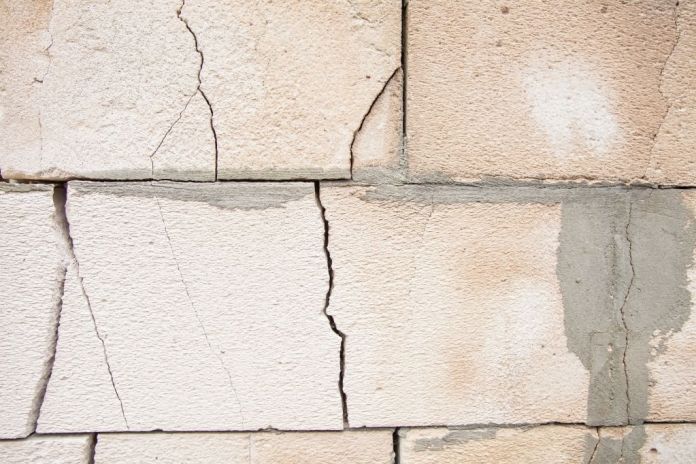Crack in basement wall leaking water is a common warranty problem. Many construction workers agree that cracks in the basement wall can damage the building. Builders and house owners always search for a solution to water leaking into the basement. Basements will be used for some purpose; therefore, keeping them dry is essential.
Fundamental Reasons For A Crack In Basement Wall Leaking Water
#1. Shrinkage
Shrinkage happens after a house is built. The concrete foundation dries too fast after being poured, creating hairline cracks and shrinking.
#2. Settling
Cracks will appear after the construction is finished. The foundation is placed onto the ground that still wants to compress. The less the compression is, the more minor cracks are. If the ground continues cramming, the existing foundation cracks become badly broader, creating new gaps. In some cases, it can even create a crack in basement floor.
#3. Movement
Movement is the main reason for cracks in the basement wall leaking water. It causes cracks. If the ground around the foundation moves and shifts, it will create damage. The cracks will increase in quantity and size if the ground continues moving.
Read More: Why You Should Hire Montgomery County Roofing Contractors?
How To Fix A Leaking Crack In Basement Wall
1. Diagnose
First, of course, you need to inspect your drain. There are two resources of moisture and water in basements that come from two sources. The first source is inside humidity that condenses on low-temperature surfaces. For instance, water droplets form on a cold drink on a humid day. The other source is outside water or water vapor. The soil around your foundation can be saturated by groundwater, melting snow, or rainwater that also can leak in. Water liquid runs through crevices while water vapor penetrates porous concrete or masonry walls.
To look for the reason, you should tape aluminum foil to the basement wall and check it later, maybe a few days. If you see moisture on the outside surface of aluminum foil, it means the space has high indoor humidity. If you see smoke behind the foil, water vapor leaks through the wall. When checking and renovating this kind of wall crack, using the appropriate tools like strongboy props is very important.
You may want to read more: Basement Window Types – How to Choose The Best One?
2. Eliminate Excess Humidity
Remove sources of moist air will make the basement dried out. Use foil tape to cover leaky dryer vents and stop unwanted humid air from entering your basement. It’s not good to use only duct tape because it may fall off easily. Install a vent fan to your basement bathroom and turn it on while you take a shower. Moreover, close windows while the weather has high humidity. Turn on the dehumidifier if you still see condensation.
3. Insulate Pipes
It would help if you handled condensation dripping from cold pipes. Use foam pipe insulation to seal cold water pipes, and then the condensation is controlled. The foam insulation is a good choice as it doesn’t cost a lot, and you easily cut it with scissors.
4. Insulate Basement Walls
To hinder condensation, you must insulate exterior walls. You can insulate basement walls to save energy and cut down the heating bill if you live in cold-weather places. If water leaks from outside, you shouldn’t wrap the walls with insulation because it’s the mold condition.
Read more: Five Tips on Choosing the Best Plumber In Arlington.
5. Foundation Leak Fixing
Water and moisture can leak in the basement through holes and cracks in the foundation. Use hydraulic cement to patch holes. Hydraulic cement can set up underwater and broaden to cover the hole and block the plug.
You use an angle grinder fitted with a diamond blade or masonry-cutting disc or a cold chisel to make the hole bigger or to shape in an inverted “V.” Remember to follow the instructions to mix and use the hydraulic cement.
Read more: How To Clean Temporary Wallpapers
6. Waterproofing Basement Walls
Waterproofing materials fill the pores in the concrete and masonry walls. They will stop water from leaking. The covering layers need to be applied to bare concrete or masonry walls. Use a wire brush to remove loose material. Get rid of any white powdery with masonry cleaner.
Don’t spread masonry waterproofing products too thin. This is a common mistake. It would help if you filled all pinholes to make a continuous waterproofing membrane. Use the brush to apply the layer in all directions to fill all pinholes. Apply the second layer after you finish the first one.
7. Drainage System
It would help if you tried to install drainage tubing under the basement floor. It will connect to a sump basket and pump. This is an excellent method to eliminate the basement wall leaking water. You have to spend an amount of money to install a system in the standard-size basement.
8. Drainage Mats
Mats help air to circulate below the flooring and create a moisture barrier. Moreover, they also make an insulating layer of air between the floor and cold concrete. This cut down the moisture damage from condensation or water vapor migrating through the concrete.
9. Sump Pump, Gutters & Downspout Extenders
Installing a basement drainage system will help you a lot to solve the basement wall leaking water. You also can build gutters and downspouts if your basement leaks after it rains.
Watch this clip to get more tips:
Conclusion
There are various ways to cope with the crack in the basement wall leaking water. I hope that you can find an effective solution to adopt. Remember to do a regular complete check of the ground around your foundation.
How to handle crack in basement walls and leaking water that is a problem to solve immediately. It would help if you stopped leakage before it got worse.



















